 ... ...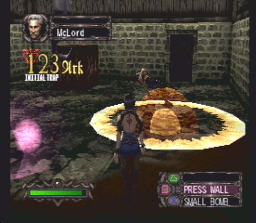
I have to wonder if part of the problem with today's games is that many of them aren't getting the criticism they truly deserve. It seems as though anything that is at least playable gets passed off as a great "work of art", and many games get misrepresented one way or another. That is what I was primarily thinking about while playing Kagero, which has garnered much praise by various sites and publications. First of all, I'm not even sure what made me want to play Kagero. I don't even remember why I bought it, other than, perhaps, a tempting discount price. (I certainly wasn't enticed by its cover art; it's some of the ugliest I've ever seen!) Maybe it was a strange desire to try something different. Kagero is the sequel to Tecmo's Deception, which I also own, but have not yet played. In both games, you play the role of "evil" as you lure victims into your castle stronghold and spring deadly traps on them, which I thought was a really intriguing concept. I had heard that Kagero was a little easier to get into than Deception, and since its story is completely unrelated, I decided to play it first. Kagero is a game that takes a lot of getting used-to, and at first, I couldn't stand playing it more than an hour a day. It eventually got to the point where I found myself hating it, and I was all prepared to give it a very scathing review. But after replaying and beating it a few more times, I started to feel less "hardened" towards it. Maybe I was starting to get used to its unusual game mechanics. But for various reasons that I'll cover in this review, it's still far from being a good game.
GRAPHICS:
Kagero opens up with an FMV sequence in which people look like they're made of rubber and move as though they're on a planet with much lighter gravity than earth's. As far as FMV's go, at least the picture quality is very decent, but this is the only FMV sequence in the game. The rest of the story is told with real-time cutscenes in which the only animations at all are the exaggerated "standing" motions of the games myriad polygonal populace. The game itself takes place in three separate "castles", which are divided into multiple rooms, and viewed from a third-person perspective from behind Millennia's (the main character's) back.
Here is the good news about the graphics: The 3D polygonal character models look pretty damn good. I really liked the designs of most of the enemies. You'll fight every medieval stereotype in the book, including knights, archers, wizards, priests, sorceresses, thieves, ninjas, barbarians, and other more bizarre professions. There is a good amount of detail in the castle environments, and even though you only fight in three locations, the rooms are varied enough to keep things interesting; some have elegant marble halls and carpets, while others look like roughly-hewn dungeon caves. Some of the 3D trap models look fantastic as well.
And now for the bad news: Despite a good amount of detail and variety in the settings, everything appears paper-thin. Walls and other objects just don't seem to have mass or substance and it doesn't help that the polygons sometimes tear or break away. When moving around, the graphics appear to have that "fishbowl" look, as the textures often ripple and vibrate. The characters are drawn well, but their animations tend to be slow, often giving the game the feeling that it's taking place in invisible molasses. Millennia's left arm is clearly much longer than her right arm. Finally, the cutscenes leave much to be desired. There is one in particular in which two main characters give a speech to a crowd of villagers. The main characters are fully 3D polygonal models. The villagers are not. They are flat, one-dimensional images, which makes this scene look unintentionally hilarious because it appears the main characters are talking to a bunch of cardboard cut-outs.
 ... ...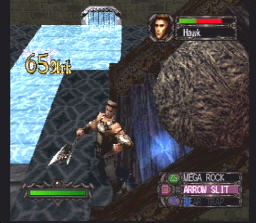
SOUND:
For the most part, the music in Kagero is neither good nor bad; it's just there. Much of it is ambient or just plain weird, consisting of howling winds and creepy (almost Satanic) chantings. But at certain times, when the music actually carries a melody or a beat, it's quite good. There is one chapter, the most crucial one in the game for deciding the story's outcome, where the music is very emotionally-charged, in an almost hypnotic way. It practically made me care a bit about what was going on and about all of these characters who pretty much act like disposable mannequins, otherwise. I also think the end credits music, which is the same no matter which of the game's multiple endings you get, is pretty good.
CONTROL:
The play control is the main reason I feel that Kagero fails to be a decent game. Milennia's movement is far too slow. You don't even have analog control unless you have the vibration feature turned on. Setting up elaborate or creative trap combinations is nigh futile, because it's almost impossible to lure even the dumbest of enemies into them. Since the view is third-person perspective, if something is chasing Millennia, you cannot see how close it is to her. If you turn around to look at it, Millennia turns so slowly that the enemy will most likely be on your back, slashing away with whatever weapon it has by the time she finishes rotating. And here's the real kicker: The game's demo shows Millennia moving and turning much faster than she does in the actual game! What the hell??
Trap placement is simple. You place them around the room using a menu and a grid-based system. Each kind of trap (wall, ceiling, and floor), is assigned to one of the controller's buttons, and a little graph in the bottom-right of the screen tells you which is which. Once a trap is fully-charged, pressing the corresponding button will activate that trap. But therein lies another problem - many traps just take too long to charge. If an enemy is chasing you, and you want to place a bomb in its path, it most likely won't work, because the bomb needs time to charge, and you'll need to keep moving so you won't be overtaken by the enemy.
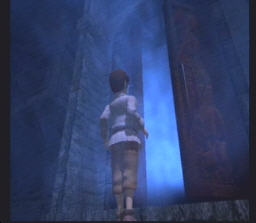 ... ...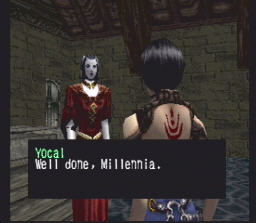
STORY/ATMOSPHERE:
In Kagero, you play the role of Millennia, an "innocent" human girl who was kidnapped and brainwashed into performing evil deeds by a somewhat-evil race of beings called "Timenoids" (yes, "Timenoids"...I know, it's a stupid name). I say "somewhat"-evil, because almost nobody in this game is truly evil or truly good. The Timenoids keep peace in the land, and they are immortal. However, the one thing that makes them "evil" is that they gain immortality by sacrificing human souls, which is why they've brainwashed Milennia. The Timenoids want Milennia to lure humans into her castle and kill them by catching them in deadly traps. There are several groups of humans who are fighting against the Timenoids and other humans whose intentions are less than noble, making it very difficult to find anyone in this game whom you can side with. The plot gets really messy at times, and the dialogue is often boring or repetitive. Just about everyone who enters the castle makes some kind of comment about Millennia being "just a girl". Millennia, herself, seems too "puppet-like" (maybe there's a reason the Timenoids call her mission the "Marionette Project".) Although the choices you make will determine the outcome and the ending, whether Millennia becomes truly "evil" or not, I still wish you could have a little more control over her decisions in some cases. There's almost never a chance to just outright defy your orders, so for most missions you have no choice but to kill, kill, kill.
And kill all kinds of people, you will, including castle invaders who are just out to plunder, humans who are fighting the Timenoids, and even the Timenoids, themselves, eventually. In some cases, you'll even have the opportunity to fight innocent villagers, but you can also choose to let them go. There's one particularly disturbing chapter involving a group of villagers who have come to the castle seeking a cure for their sick child, which is so manipulative and inappropriate. Offing those characters in order to achieve multiple ending #1 is one of the most uneasy things I've ever had to do in a video game.
Although I will admit that there were times when I was endeared to it, Kagero still fails in its story because very little of what goes on amounts to much. Characters are introduced only to be killed moments later in the castle, and much of the plot is cheesy and ludicrous. However, Kagero also disappoints in its atmosphere; It just doesn't feel dark and creepy at all. Maybe it's those backgrounds made of cardboard and paper, or the fact that many of your enemies walk so slowly and stupidly into the same traps over and over again, but the game almost takes on an unintentional comedic feel. Is it so morally wrong to find it hilarious that a knight who's had a giant boulder dropped on his head, a bomb blast him halfway across a room, and a buzzsaw blade fly through his chest, would still stagger to his feet and slowly limp after you with a sword that he can now barely lift?
CHALLENGE:
One of the biggest problems with Kagero is that it is not challenging. I discovered one simple trap combination that would work on just about every enemy in the entire game. It consisted of setting up traps by a door, waiting for the enemy to walk through the door, setting off the traps, and then running to the next room to repeat those steps. Once the Spring Floor became available this scenario got me through almost every situation:
1. Put a Spring Floor directly in front of a door and aim the directional arrow towards a wall.
2. Place a rock or other object that falls from the ceiling on the square by the wall where the Spring Floor will make the victim land.
3. Place a wall trap, such as an arrow, on the wall nearby.
As soon as the victim enters the room, activate the Spring Floor. The victim will be tossed against the wall, so activate the ceiling trap and watch it fall on his/her head. If the victim still has life energy left and staggers to his/her feet, activate the wall trap to spear him/her with it. If the victim is still alive now, simply run to the next room, and repeat steps 1-3. It does not matter what kind of enemy you are fighting, this works on just about all of them. Now imagine doing this for up to 26 missions with multiple characters per mission, and you'll see why this game gets very repetitive. Yes, I realize it's possible to set up more creative trap designs, but why bother when this one works so well, and the control makes it so difficult to do otherwise?
Enemies have different abilities depending on what profession they are. Knights are slow, but do a lot of damage to Millennia with their swords. Magicians can attack from a distance with lightning bolts and other spells. Ninjas move swiftly, throw darts, and can turn invisible. Some enemies are initially impervious to certain kinds of traps, but by simply lowering their guard, they become just as vulnerable as anyone else. (Hint: The almighty Spring Floor does it again!) By generally using the above tactic, it's almost impossible to lose to anyone, regardless of what character class they are.
FUN:
Kagero's scenarios play out a little differently depending on who you kill, who you let go, and how you answer certain questions asked of you. However, the basic gameplay never really changes, and since most enemies can be beaten the same way, it makes little difference if your decisions cause you to fight knights in the next round or magicians. Sometimes, you may have a secondary goal, such as keeping invaders from setting off a bomb in a certain room. Although this adds a little more strategy, in some cases it makes matters worse. It's annoying to have to wait around in the room with the bomb for the invaders to come to you, which I found was the only surefire way of making sure they don't activate it.
The gameplay also feels a bit too limiting. You can make dozens of different kinds of traps, but can only take three of each kind (wall, floor, and ceiling) into a mission. Why didn't they just allow you to choose from all of the traps you've made? What's the point of having lots of traps, since you'll most likely just take the strongest ones with you into battle every time? You can also only place one of each kind of trap in a room at a time. Want to have a Spring Floor send a victim flying into a pool of water, then use a rod to electrify the water? Oops, can't do it, because Spring Floors and rods are both floor traps and you can only use one.
Upon completing Kagero, you will get one of the game's four different endings. If you choose to start a new game, you will have a new trap available to you. The trap you get depends on what ending you received, and getting all four endings saved on one file nets you a very special trap to use. This gives Kagero some replay value, and this is probably the only reason that I did replay it. The first time I beat Kagero, it took me a little over 9 hours. The last time I beat it, my time was just over 5 1/2 hours. It may sound like Kagero is short, but it often felt like it was going on forever. I guess that's what happens when games are as repetitive and poorly designed as this.
 ... ...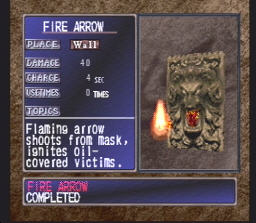
I have to admit that when I first played Kagero, I had a really strong dislike for it. I was all prepared to give it an all-out negative review. But then when I replayed it, a few things endeared me to it; certain parts of its story, its music, the unintentional humor, and maybe an occasional satisfying victory. I no longer feel "angry" with it. The game's story seems to want you to feel sorry for the characters, but I ended up feeling sorry for the game, itself. It's below average and, after beating it four times, not something I would ever really want to play again.
OVERALL
SCORE: 2/5
BACK TO PLAYSTATION
REVIEWS BACK TO MAIN
PAGE
|
|